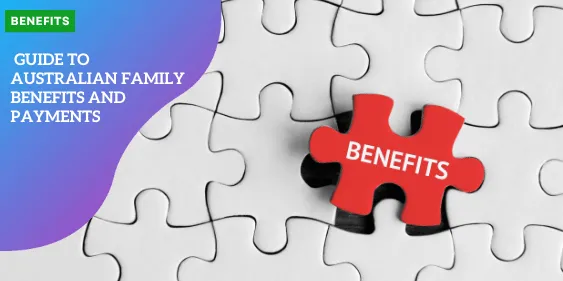Guide to Australian Family Benefits and Payments

Overview of Available Benefits and Payments for Families
Raising a family in Australia comes with numerous financial responsibilities.
To assist families in managing these costs, the Australian government offers a wide range of benefits and payments.
These benefits cover everything from the early stages of parenthood to the teenage years of a child. Key programs include:
- Paid Parental Leave Scheme: Provides financial support to eligible working parents, allowing them to take time off after the birth or adoption of a child.
- Family Tax Benefit: A two-part payment to help with the costs of raising children.
- Newborn Upfront Payment and Newborn Supplement: Offers financial aid when you start caring for a new baby.
- Multiple Birth Allowance: Additional support for parents of triplets or more.
- Stillborn Baby Payment: Assists with costs associated with a stillborn child.
- Double Orphan Pension: Regular payments for caregivers of orphaned children.
- Transition to Independent Living Allowance: Supports young people moving from formal care to independent living.
Importance of Government Support for Raising Children
Government support plays a crucial role in easing the financial burden on families.
By providing these resources, the government helps ensure that children can grow up in healthy and supportive environments.
The financial aid helps cover essential costs such as childcare, education, and healthcare, allowing parents to focus more on the well-being of their children.
This social safety net is vital for maintaining family stability and ensuring that all children, regardless of their family’s financial circumstances, have the opportunity to thrive.
Brief Explanation of Eligibility Criteria
Eligibility for these benefits varies depending on the type of support.
Common criteria include:
- Income and Assets Test: Many benefits, such as the Family Tax Benefit, require parents to meet specific income and asset thresholds.
- Residency Requirements: Most benefits are available to Australian residents or citizens.
- Employment Status: Some benefits, like the Paid Parental Leave Scheme, are reserved for working parents.
- Family Composition: Certain payments are designed for specific family situations, such as the Multiple Birth Allowance for parents with triplets or more.
Each benefit has its own set of detailed eligibility requirements, which must be thoroughly reviewed when applying.
These financial aids and support systems form a comprehensive framework to assist Australian families at various stages of child-rearing.
It’s essential to understand the scope of these benefits and identify which ones apply to your specific needs.
This completes the overview of available benefits and the importance of government support, setting the stage for a deeper dive into individual programs and their specific details.
Paid Parental Leave Scheme
Purpose and Eligibility for Parental Leave Pay
The Paid Parental Leave (PPL) scheme aims to support eligible working parents by offering financial assistance during time off after the birth or adoption of a child.
This benefit underscores the importance of allowing parents to bond with their new child without the added stress of financial instability.
To qualify for Parental Leave Pay, parents must meet several criteria:
- Work Test: Parents need to have worked for 10 of the 13 months before the birth or adoption.
- Income Test: The individual’s adjusted taxable income should be $150,000 or less in the financial year before the date of birth or adoption or claim.
- Primary Carer: The parent must be the primary carer of the newborn or adopted child.
Support for Working Parents After Birth or Adoption
The PPL scheme not only provides monetary benefits but also underscores societal support for working parents.
This program allows parents to take essential time off work to care for their newborn or recently adopted child, promoting better health and developmental outcomes for the child and better mental well-being for the parents.
Additionally, it helps maintain employment ties by ensuring parents can return to their jobs after their leave period.
Duration and Amount of Payment
Eligible parents can receive Parental Leave Pay for up to 18 weeks.
The payment is based on the national minimum wage, ensuring that the financial assistance is standardized and equitable.
For up-to-date details on the exact payment rate, one can refer to government resources.
The payment can be made in one block or in installments, depending on what suits the family’s needs best.
This flexibility is another facet of the government’s commitment to supporting family well-being.
This crucial scheme ensures parents can focus on their families during this significant period, laying a strong foundation for the child’s future.
Family Tax Benefit
Explanation of Part A and Part B Payments
The Family Tax Benefit (FTB) is a cornerstone of Australia’s financial support for families, designed to help with the costs of raising children.
It consists of two parts: Part A and Part B, each offering distinct benefits to cater to different family needs.
Family Tax Benefit Part A
Part A is paid per child and is income-tested, assisting families with the cost of raising children.
To be eligible, your family’s income must be below a certain threshold.
Payments are made either fortnightly or annually, depending on your preferences.
This benefit covers a wide range of expenses, including daily living costs, school expenses, and other child-specific needs.
Family Tax Benefit Part B
Part B provides additional assistance to single-parent families and families with one main income earner.
Like Part A, it is income-tested but focuses on the secondary earner’s income, with stricter criteria for higher earnings.
The goal is to support families where one parent may be staying at home to care for young children.
How Family Tax Benefit Helps with Child-Raising Costs
The Family Tax Benefit significantly alleviates the financial pressures associated with raising children.
By providing regular payments, it ensures that families can cover essential costs such as food, clothing, education, and healthcare.
This support extends from birth through late teens, adapting to the growing needs of the child and the evolving circumstances of the family.
Eligibility Requirements and Payment Rates
General Eligibility
To qualify for FTB, you must meet the following conditions:
- Be caring for a dependent child aged 0-15, or 16-19 if they are in full-time secondary education.
- Be an Australian resident or meet residency requirements.
- Comply with the income test and other testing criteria specific to Parts A and B.
Payment Rates
The payment rates for FTB vary:
- Part A: The rate depends on the family’s annual income and the number of children. For families with incomes below the higher threshold, the maximum rate is payable.
- Part B: The rate depends on the age of the youngest child and the income of the secondary earner. Higher payments are made for families with children under five, and lower rates for those with older children.
By recognizing the diverse needs of families, the Family Tax Benefit ensures tailored support, empowering families to provide better opportunities and care for their children.
We now move from general family tax benefits to specialized support provided for newborns and multiple births.
Newborn and Multiple Birth Support
Newborn Upfront Payment and Newborn Supplement
The Newborn Upfront Payment and Newborn Supplement offer families crucial financial support during the early days of a child’s life.
This assistance comes in two parts:
- Newborn Upfront Payment: A lump sum payment provided when you start caring for a newborn or a child that has recently come into your care. This payment is designed to help with immediate expenses and is paid together with your Family Tax Benefit Part A.
- Newborn Supplement: An increase to your Family Tax Benefit Part A. This increase is distributed over a period and can be received fortnightly or as part of your annual Family Tax Benefit payment.
Both the Newborn Upfront Payment and Newborn Supplement provide financial relief, ensuring families can meet the initial costs associated with the arrival of a new child.
Multiple Birth Allowance
Families welcoming multiple births face unique financial challenges.
The Multiple Birth Allowance offers support specifically for families with triplets or more.
This allowance provides an additional payment to help cover the increased costs of raising multiple children born at the same time.
The Multiple Birth Allowance acknowledges the significant financial demands placed on these families and provides support to make this transition easier.
Eligibility Criteria and Application Process
To access the Newborn Upfront Payment, Newborn Supplement, or Multiple Birth Allowance, certain eligibility criteria must be met:
- Newborn Upfront Payment and Newborn Supplement:
- You must be eligible for Family Tax Benefit Part A.
- You must be the primary carer for the child.
- The child must be under one year old or have come into your care within the past 12 months.
- Multiple Birth Allowance:
- You must have triplets or more to qualify.
- All children must be under six years of age.
The application process is straightforward. If you are already receiving Family Tax Benefit Part A, the payments will generally be automatically adjusted to include the Newborn Upfront Payment and Newborn Supplement.
For the Multiple Birth Allowance, you may need to provide additional documentation to verify the birth details.
Application Tips
To ensure a smooth application process, remember to:
- Gather all necessary documentation, including birth certificates or legal proof of guardianship.
- Keep your details updated in the myGov portal or through Centrelink to avoid delays.
While these benefits are invaluable, staying informed about the various options available can significantly ease the financial burdens of welcoming a newborn or multiple births.
Special Circumstances Benefits
Navigating the challenges that come with special family circumstances can be daunting.
The Australian Government offers several specific benefits to support families during particularly difficult times.
Stillborn Baby Payment
The loss of a child through stillbirth is an unimaginable ordeal, and the financial burden can add to the emotional strain.
The Stillborn Baby Payment provides financial assistance to cover the extra costs associated with a stillborn child.
This payment aims to help bereaved families manage immediate expenses during this difficult time, alleviating some of the financial stress.
Double Orphan Pension
Caring for orphaned children presents unique challenges, and the Double Orphan Pension is designed to provide support in such situations.
This regular payment is for caregivers looking after children whose parents have either deceased or are unable to care for them.
By offering this support, the Australian Government helps ensure that children in these unfortunate circumstances have their basic needs met, while also aiding their caregivers financially.
Transition to Independent Living Allowance
Youth transitioning from formal out-of-home care to independent living face a precarious period where support can make a significant difference.
The Transition to Independent Living Allowance (TILA) provides one-off financial assistance to these young individuals.
TILA helps cover various costs associated with establishing an independent life, such as securing housing, education, and employment opportunities.
This support is crucial in setting up a stable foundation for their future.
By addressing these special circumstances, the Australian Government provides essential support to families during some of the most challenging times.
These benefits aim to alleviate financial burdens, allowing families to focus on emotional healing and stability.
Additional Financial Support
While the primary family benefits cover a broad range of needs, Australia also offers specific types of additional financial support that can be crucial for families in unique circumstances.
Here, we’ll explore the Single Income Family Supplement and the Energy Supplement, both of which are currently closed to new recipients, and other potential benefits that may be available to Australian families.
Single Income Family Supplement
The Single Income Family Supplement (SIFS) was designed to help families where the main income earner makes between $68,000 and $150,000 annually.
This benefit provided up to $300 per year to assist these families with the cost of living.
However, as of July 1, 2017, SIFS has been closed to new recipients. Existing recipients may still receive payments, but no new applications are being accepted.
Energy Supplement
The Energy Supplement was an additional payment aimed at helping families and individuals manage their energy costs.
It was available to those who received certain other government payments, including Family Tax Benefit.
Like the SIFS, the Energy Supplement was closed to new Family Tax Benefit recipients from September 20, 2016.
Current beneficiaries of Family Tax Benefit who have been receiving the supplement will continue to do so, but no new beneficiaries will be added.
Other Potential Benefits for Families
Apart from the main support schemes and the supplements that are now closed to new recipients, there are other potential benefits that families might be eligible for under specific conditions.
These can include:
- Health Care Cards: Low-income families may qualify for Health Care Cards, which offer reduced costs for prescription medicines, and potentially, additional concessions for health, education, and childcare.
- Child Care Subsidy: Families needing assistance with daycare costs can apply for the Child Care Subsidy, which covers a portion of childcare expenses for eligible families, thus making child care more affordable.
- Carers Allowance: Families caring for children with serious disabilities or medical conditions may be eligible for the Carer’s Allowance, which provides ongoing financial support to caregivers.
Australia’s additional financial support options might be limited in terms of new enrollments for some programs, but the existing supports ensure that families can receive the help they need based on their specific situations.
This forms part of the broader landscape of family benefits and payments designed to support families at different stages and under various circumstances.
Applying for Benefits and Payments
How to Check Eligibility and Apply for Benefits
Navigating the process of applying for family benefits and payments can feel overwhelming.
To get started, it’s essential to check your eligibility. Each benefit has specific criteria—income thresholds, the number of children, and employment status, among others.
The Services Australia website provides a comprehensive eligibility tool that helps prospective applicants determine which benefits they qualify for.
Once you’ve confirmed your eligibility, you can apply for benefits through your MyGov account linked to Centrelink.
The online application process is user-friendly, and there’s also a step-by-step guide available for those unfamiliar with digital applications.
Required Documentation and Information
Before you begin your application, gather all necessary documentation.
Here’s a checklist of typical documents you might need:
- Proof of identity (Passport, Driver’s License)
- Tax File Number (TFN)
- Income details (Recent pay slips, tax return)
- Birth certificate(s) of your child(ren)
- Employment history (For Paid Parental Leave)
- Bank account details
Having these documents ready will streamline your application process and minimize delays.
Timelines and Processing of Applications
Once you submit your application, it’s essential to allow time for processing.
Generally, it takes about 28 days for most family benefits applications to be processed.
However, for certain payments like Paid Parental Leave or Family Tax Benefit, this can sometimes be expedited, especially if all required documentation was submitted accurately.
After your application is processed, you’ll receive a notification via your preferred communication method (usually email or postal mail), detailing the outcome and the scheduled payment dates if approved.
By understanding how to check your eligibility, preparing the required documentation, and being patient during the processing period, you can successfully navigate the application process for Australia’s family benefits and payments.
Conclusion and Resources
Recap of Available Family Benefits and Payments
Australia offers an array of benefits to support families in raising their children, ranging from birth to late teens.
The Paid Parental Leave scheme provides financial assistance to eligible working parents, enabling them to take time off work after a birth or adoption.
The Family Tax Benefit (Part A and Part B) helps alleviate child-raising costs, ensuring families receive the support they need at different stages of their children’s lives.
Newborn Upfront Payment and Newborn Supplement offer crucial financial aid when a new baby enters the family, while the Multiple Birth Allowance helps families with triplets or more manage their increased costs.
Special Circumstances Benefits like the Stillborn Baby Payment and Double Orphan Pension provide vital support during challenging times such as a stillbirth or when caring for orphaned children.
Additionally, the Transition to Independent Living Allowance assists youth moving from out-of-home care to independent living.
Importance of Staying Informed About Changes to Benefits
Government policies and benefits can change, affecting eligibility and payment rates.
Staying informed about these changes is crucial for maximizing the support available to your family.
Regularly check official government websites and updates to ensure you have the most current information.
Where to Find More Information and Assistance
For comprehensive details about family benefits and to verify your eligibility, visit Services Australia.
Their website provides extensive resources, including an online tool to help you check eligibility and apply for benefits.
You can also seek assistance from local community centers, social workers, or financial advisors who specialize in family support services.
Staying proactive and informed can make a significant difference in managing the financial aspects of raising a family, ensuring that you take full advantage of the support available to you.







